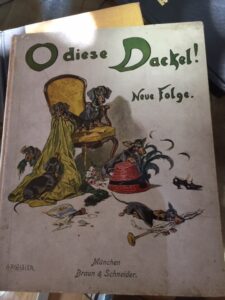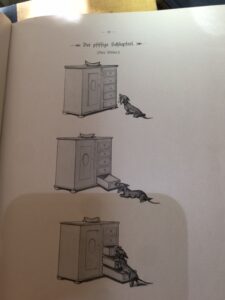 Two artists received top billing for illustrations in this book, Adolf Hengeler (1863-1927) and August Roeseler (1866-1943). The entire flavor of an era comes contained in this one little book. O Diese Dackel: Lustiges aus dem Leben unserer kleinen Krummbeingen published in 1912 in Munich. If you don’t read German, the title reads something like O This Dachshund: Funnies about the life of our small odd-shaped being. My German is very rusty. My mother spoke German, and both parents had German roots.
Two artists received top billing for illustrations in this book, Adolf Hengeler (1863-1927) and August Roeseler (1866-1943). The entire flavor of an era comes contained in this one little book. O Diese Dackel: Lustiges aus dem Leben unserer kleinen Krummbeingen published in 1912 in Munich. If you don’t read German, the title reads something like O This Dachshund: Funnies about the life of our small odd-shaped being. My German is very rusty. My mother spoke German, and both parents had German roots.
Both artists resided of Munich, and both studied at the Munich Academy of Fine Art. You might think a serious art academy taught artists to grapple with issues of the day, and not to focused on such distracting art as funny illustrations. That’s exactly why this little book sums up the zeitgeist of the last few years of the 19th century, beginning of the 20th century so WELL. Two years after the publication of this book, Germany entered the bloody WWI. In Bavaria, deep dark clouds arrived on the horizon….
I adore this little slim volume because I adore the breed of dog it celebrates, the Doxie. The illustrations are lighthearted, comical, sentimental, and accurate. The summary of those four words perfectly illustrates the “zeitgeist” or flavor of the time in Bavaria. My ancestors came from that region right about that time, emigrating to St. Louis.
My Favorite Illustration by August Roeseler
 My favorite Roeseler dachshund illustration, originally published in the magazine Fliegende Blatter (Flying Leaves) in Munich on August 31, 1900, is not in the book. In the illustration doxies salivate over a sausage shape in the sky. Roeseler used this to comment on the flight of Count Ferdinand von Zeppelin’s blimp over the Bodensee at Friedrichshafen (Lake Constance). I found the illustration, titled “Riesenwurst” (literally travelling sausage), on “Read Seen Heard” by collector Kihm.
My favorite Roeseler dachshund illustration, originally published in the magazine Fliegende Blatter (Flying Leaves) in Munich on August 31, 1900, is not in the book. In the illustration doxies salivate over a sausage shape in the sky. Roeseler used this to comment on the flight of Count Ferdinand von Zeppelin’s blimp over the Bodensee at Friedrichshafen (Lake Constance). I found the illustration, titled “Riesenwurst” (literally travelling sausage), on “Read Seen Heard” by collector Kihm.
In his day Roeseler became known as the Dackelmaler (Doxie painter). A theme in his work became the juxtaposition of the wiener dog with actual wieners (Wurst). One found these on a menu he designed for the famous hotspot of the Oktoberfest, the Hofbräuhaus am Platzl. He designed beer steins for Villory and Boch, Marzi and Remy, and Mettlach. Roeseler also worked as a poster artist, genre oil painter (mostly drinking men with dogs!), and cartoonist. Collectors look for his illustration of the bumpkins of Bavaria in “Jugend,” and “Simplicissimus.” He collaborated with the co-illustrator of O Diese Dackel, Hengeler, on Hengeler’s magazine Fliegende Blatter.
Adolf Hengeler Drew Five Thousand Illustrations Over Twenty Years
Hengeler drew five thousand illustrations before he married the daughter of the Court Jeweler for King Ludwig III of Bavaria. He took a professorship at the academy of Arts, Munich, where he apprenticed as a lithographer in 1878, and studied copper plate engraving. When he married into money, he assumed the more refined profession of oil painter!
His paintings of the fin de siècle also contained the fanciful zeitgeist of the era. I always considered this troubling. In Germany of this period, the poor were EXTREMELY poor, the rich EXTRAORDINARILY rich, as war brewed. Painting themes of humor and caricature, landscapes with mythic creatures, Bavarian forests replete with religious figures, and yes, drinking men with dogs, remained popular.
Hengeler’s work garnered some acclaim
He showed in the famous 1893 Munich Secession, in the Great Berlin Art Exhibition, and four shows at the Munich Glass Palace.
His grandson Peter Bomhard (1919-1979) became an art historian. He endowed his grandfather’s home village of Kempten in Upper Bavaria the complete collection of art and furnishings. Bomhard requested that the local museum, the Allgau Museum, create a wing to reproduce his grandfather’s studio. The Hengeler Room became the focus of a celebration in 2013 of Hengeler’s 150 birthday.
Perhaps as an answer to the escapist art of the turn of the last century, practiced by Hengeler, the town commissioned a musical in Hengeler’s honor. They called the play “The So-Called Hengeler Art Revue, or the Strange Sorrows of an Art Professor.” I almost hear the tubas and accordions as I write this.
The value of O Diese Dackel is $100. I’m indebted to my German friend Imke. He noticed I owned two “Dackels,” Bark then Bear, in rapid succession and gifted me this book.